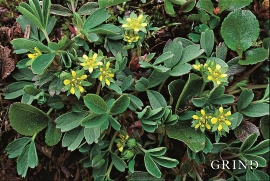Published: 23.01.2017 | Author: Mary Losvik
Mountain farming is still alive in Kvassdalen, as it has been for more than two hundred years. Therefore, the valley has not become overgrown by thicket and trees, but remains open and light. There are not many such mountain farm areas still operating in Hordaland any longer. Cows and sheep still graze here.
The mountain farming area in Holo in Kvalldalen valley lies close beside the main road just before the ascent on the long hairpin up toward Vikafjellet. One can see goats along the road, the most important livestock on the farms, and real goat cheese is sold on the site. It is the nourishing phyllite soil and plenty of loose sediments that give the fertile farming conditions here. The ice age glaciers left behind a lot of moraine material, and the river built up low terraces on the otherwise flat valley bottom. On the steep valley sides there are large amounts of scree material, mostly from avalanches.
Up through the years, animals from the farms further down in the valley have come to Holo in summer to fatten up and produce enough milk to support a large-scale sale of butter and cheese. This also made it possible to harvest a lot of winter fodder on the farmland left vacant at home at the end of the summer.
Holo is typical of the old mountain farms in western Norway: The buildings lie close together where it is flat, where the land is open and the animals have grazed down the grass. Between steep mountain slopes, the valley bottom provides tempting grazing pastures of grasses and heather. Further up, there is an area with small forests of birch, but avalanches and unstable earth have removed the forest many places. Several ferns such as heath fern and alpine lady-fern manage nonetheless on this scree and grow in enormous amounts.
As is the case in many mountain farm areas, the vegetation in Holo has components of both lowlands and high mountains, but most of all it is the extent of grazing that influences the plant life in the valley. Only the hardiest plants like, for example, garden sorrel, white clover, nettles and different species of grass and sedge survive the grazing, trampling and hard fertilization of the actual mountain meadow. Also at the bottom of the mountain slope there is grazing, but the pressure is not as hard here, and several species thrive. The hardy sorts from the mountain farm meadow grow together with the mountain plants Hornemann's Willow-herb, sibbaldia and starwort mouse-ear. Where the animals do not graze, more heather grows, such as blue heath, black crowberry and blueberry.
- Hellesnes, T. 1972. Gardssoge for Vossestrand, Vinje sokn.




